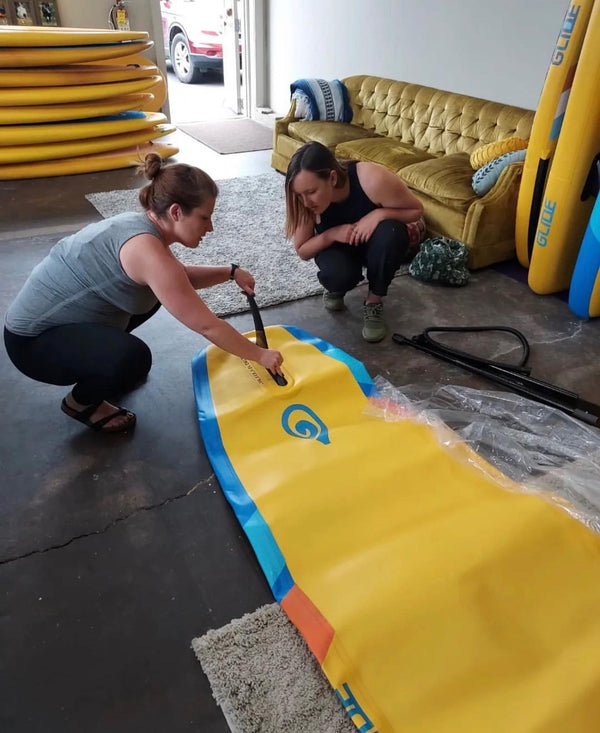
Why Is My Paddle Board Losing Air? Causes, Fixes, and Prevention
If your inflatable paddle board is losing air, don’t worry — it’s fixable. Learn the common causes, quick repairs, and prevention tips from Glide’s SUP experts.
If your inflatable paddle board seems to be losing air faster than usual, don’t panic — it’s a common issue with clear solutions. Whether it’s a minor leak, a loose valve, or normal air pressure changes, understanding why it happens (and how to fix it) will keep your board performing at its best.
This guide explains the main reasons your iSUP might lose air, how to locate leaks, repair them properly, and prevent future problems — helping you get the most life and reliability out of your Glide inflatable paddle board.

Common Reasons for Air Loss
1. Normal Air Pressure Changes
All inflatable paddle boards experience slight air loss over time — even when brand new.
-
Temperature shifts cause air to expand or contract.
-
Materials slowly release minimal amounts of air through micro-permeation.
💡 Tip: Check your PSI before every session. If the board feels soft, add a few pumps to bring it back to full pressure (15–20 PSI for most Glide boards).
2. Punctures or Tears
Even with heavy-duty, fusion-layer PVC, sharp rocks or debris can cause small punctures that lead to noticeable air loss.
-
Common culprits: oyster beds, barnacles, gravel launches, or dragging your board.
-
Minor punctures are usually fixable with the included Glide repair kit.
3. Loose or Leaking Valve
A slightly loose valve is one of the most frequent — and easiest — causes to fix.
-
If air escapes around the valve, use the black wrench from your Glide repair canister to gently tighten it clockwise.
-
Avoid over-tightening; a snug fit is enough to stop leaks.
If tightening doesn’t help, the valve may need replacing (contact Glide for compatible parts).
4. Damaged Seams
Your iSUP’s seams are the backbone of its structure, holding internal air pressure steady. Prolonged heat exposure or poor storage can weaken them.
-
Look for visible separation or tiny air bubbles during inflation.
-
Seam repairs are trickier — when in doubt, reach out to a professional or Glide’s support team.
🔍 How to Find the Leak
Before you can fix air loss, you need to pinpoint exactly where it’s coming from.
Visual Inspection
Fully inflate your board and inspect it under good light.
-
Pay attention to high-wear areas: the tail, nose, rail seams, and valve base.
-
Press lightly to feel for escaping air.
Soapy Water Test
Mix dish soap with water and wipe it over the surface — especially around seams and the valve.
-
Look for bubbles — they form wherever air is leaking.
-
Mark those spots with painter’s tape for easy repair later.
💡 Pro Tip: Inflate your board to full PSI before testing. Slow leaks can be subtle at lower pressure.

🩹 How to Fix Common Air Leak Issues
Small Punctures
-
Clean and dry the affected area.
-
Apply a thin layer of adhesive from your repair kit to both the patch and the puncture.
-
Wait until tacky, then press firmly and hold for 30 seconds.
-
Let it cure for at least 24 hours before reinflating.
💡 Optional: Reinforce the repair with Aquaseal FD for an extra-strong bond.
Larger Tears or Seam Problems
If your leak covers a wide area or affects the seam, avoid quick DIY fixes.
-
Contact Glide customer service or a certified SUP repair shop.
-
Trying to patch deep seam separations without proper tools can make the problem worse.
Loose or Leaking Valve
-
Deflate your board completely.
-
Insert the valve wrench and twist clockwise ¼–½ turn while pressing down on the valve base.
-
Inflate again and check for hissing.
If the leak continues, request a replacement valve from Glide or your local paddle shop.
Preventing Future Air Loss
Preventative care is the best way to keep your inflatable paddle board airtight for years.
1. Store It Properly
-
Keep your board cool, dry, and shaded — UV rays can degrade seams and PVC.
-
Avoid leaving it inflated in hot cars or direct sunlight.
-
For long-term storage, deflate slightly and roll loosely.
👉 See our full guide: Storing Your Glide Inflatable Paddle Board: Tips for Longevity
2. Maintain Proper PSI
-
Always inflate to the manufacturer’s recommended PSI (15–20 PSI for most Glide models).
-
Don’t exceed the limit — over-inflation stresses seams.
-
Check pressure before every paddle, especially after big temperature changes.
3. Rinse and Dry After Every Use
-
Saltwater and sediment can weaken the board’s materials.
-
Rinse with fresh water, dry thoroughly, and inspect for damage.
4. Avoid Rough Surfaces
-
Never drag your iSUP across rocks or docks.
-
Use a soft mat or towel when launching on gravel or sand.
When to Seek Professional Repair
If your board deflates rapidly or loses shape even after patching, don’t risk further damage — it may require a heat-weld or valve replacement.
Glide’s team or an authorized SUP repair center can re-bond seams or replace defective parts safely. 
Final Thoughts
It’s normal for your inflatable paddle board to lose a little air over time, but frequent or rapid air loss means something needs attention.
By learning to identify the cause — whether it’s a loose valve, puncture, or seam fatigue — you’ll keep your Glide iSUP performing like new.
Remember: a quick inspection after every use prevents small leaks from becoming big problems. Treat your board with care, and it’ll reward you with years of reliable adventure on the water.

